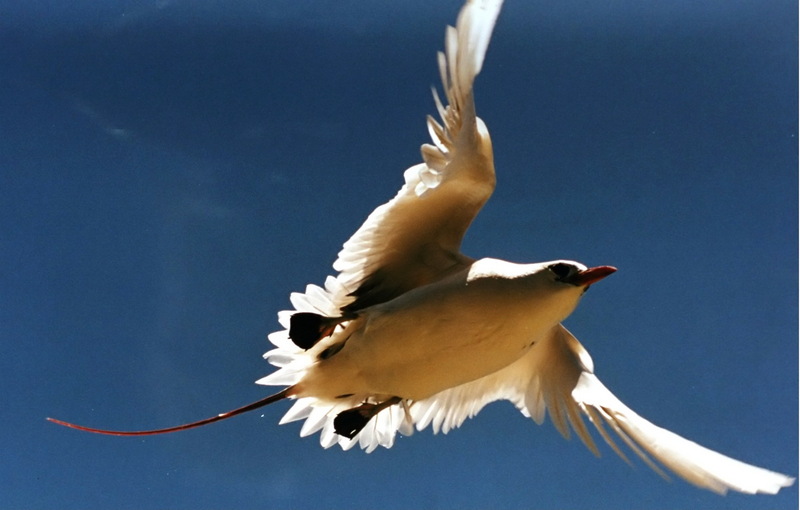|
| Query: pelecaniformes | Result: 3rd of 149 | |
Tropicbird (Family: Phaethontidae, Genus: Phaethon) - Wiki
| Subject: | Tropicbird (Family: Phaethontidae, Genus: Phaethon) - Wiki
| |

| Resolution: 1536x979
File Size: 319067 Bytes
Date: 2007:09:02 22:00:38
Upload Date: 2007:09:02 22:03:42
|
Tropicbird
From Wikipedia, the free encyclopedia
[Photo] Red-tailed Tropicbird(Phaethon rubricauda) in flight at Midway Atoll. Photograped by Mila Zinkova http://home.comcast.net/~milazinkova/Fogshadow.html
Tropicbirds are a group of three closely related pelagic seabirds of tropical oceans: The Red-billed Tropicbird, the Red-tailed Tropicbird, and the White-tailed Tropicbird.
Size and Appearance
Tropicbirds range in size from 76cm-102cm in length and 94cm-112cm in wingspan. Their plumage is predominantly white, with elongated central tail feathers. The three species will have a different combination of black markings on the face, back, and wings. Their bills are large, powerful and slightly decurved. Their heads are large and their necks are short and thick. Tropicbird legs are very short and their feet are totipalmate.
The Tropicbirds' call is typically a loud, piercing, shrill, but grating whistle, or crackle. These are often given in a rapid series when they are in a display flight at the colony.
Systematics, evolution & distribution
Tropicbirds are currently grouped in the order Pelecaniformes, which also includes the pelicans, cormorants and shags, darters, gannets and boobies and frigatebirds; in the Sibley-Ahlquist taxonomy, the Pelecaniformes have been united with other, unrelated groups into a massively paraphyletic "Ciconiiformes".
Recent research suggests that the Pelecaniformes as traditionally defined are paraphyletic too. The tropicbirds and the related prehistoric family Prophaethontidae are probably better considered a distinct order related to the Procellariiformes (Mayr, 2003; Bourdon et al., 2005) or a booby-cormorant lineage or placed into these groups as a superfamily Phaetontes.
Family Phaetontidae
Genus Phaeton
Red-billed Tropicbird Phaethon aethereus (tropical Atlantic, eastern Pacific, and Indian oceans)
Red-tailed Tropicbird, P. rubricauda (Indian Ocean and the western and central tropical Pacific)
White-tailed Tropicbird, P. lepturus (widespread in tropical waters, except in the eastern Pacific)
Heliadornis is a prehistoric genus of tropicbirds described from fossils.
Ecology and reproduction
Tropicbirds frequently catch their prey by hovering and then plunge-diving, typically only into the surface-layer of the waters. They eat mostly fish, especially flying fish, and occasionally squid. Tropicbirds tend to avoid multi-species feeding flocks as opposed to their sister Frigatebirds.
Tropicbirds are usually solitary or in pairs away from breeding colonies. There they engage in spectacular courtship displays. For several minutes, groups of 2???20 birds simultaneously and repeatedly fly around one another in large, vertical circles, while swinging the tail streamers from side to side. If the female likes the presentation, she will mate with the male in his prospective nest-site. Occasionally, disputes will occur between males trying to protect their mates and nesting areas.
Tropicbirds generally nest in holes or crevices on the bare ground. The female will lay one white egg, spotted brown and incubate for 40-46 days. The incubation is performed by both parents, but mostly the female, while the male brings food to feed the female. The chick hatches with grey down. It will stay alone in nest while both parents search for food, and they will feed the chick twice every three days until fledging, about 12-13 weeks after hatching. The young are not able to fly initially, they will float on the ocean for several days to lose weight before flight.
Tropicbird chicks have relatively slow growth relative to a nearshore bird and they also tend to accumulate fat deposits while young. That, along with one-egg clutches, appears to be an adaptation to a pelagic lifestyle where food is often gathered in big amounts, but may be hard to find.
http://en.wikipedia.org/wiki/Tropicbird
| The text in this page is based on the copyrighted Wikipedia article shown in above URL. It is used under the GNU Free Documentation License. You may redistribute it, verbatim or modified, providing that you comply with the terms of the GFDL. |
|
Comments |
|---|
| | bob |
|
| what is the sound |
| | bob |
|
| what is the sound |
| | Guest |
|
Scientific Name: Phaethon rubricauda Boddaert, 1783
Common Names: Red-tailed Tropicbird, amokura
French: Phaéton à brins rouges, Phaéton à queue rouge; German: Rotschwanz-Tropikvogel; Spanish: Rabijunco colirrojo, Rabijunco cola roja
Taxonomy: Phaeton [sic] rubricauda Boddaert, 1783, Mauritius. |
^o^
Animal Pictures Archive for smart phones
^o^
|
|
|

